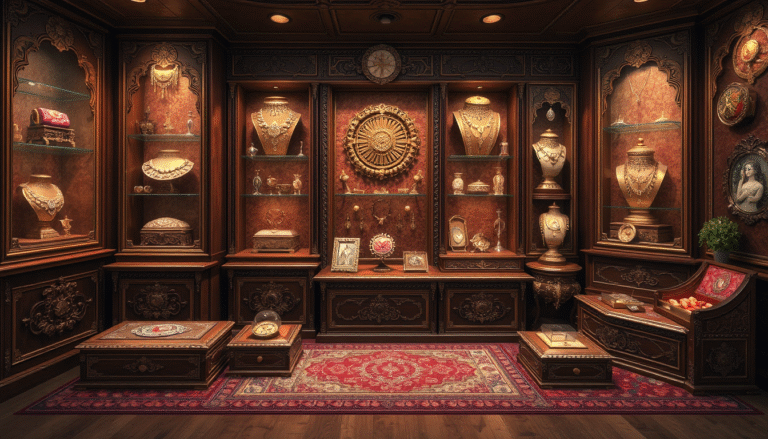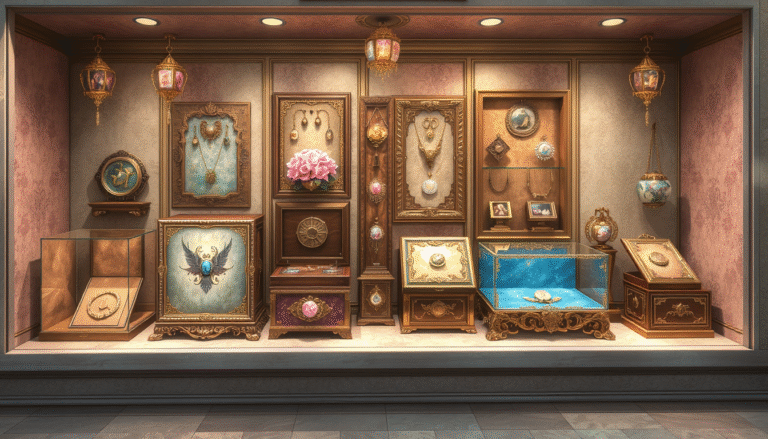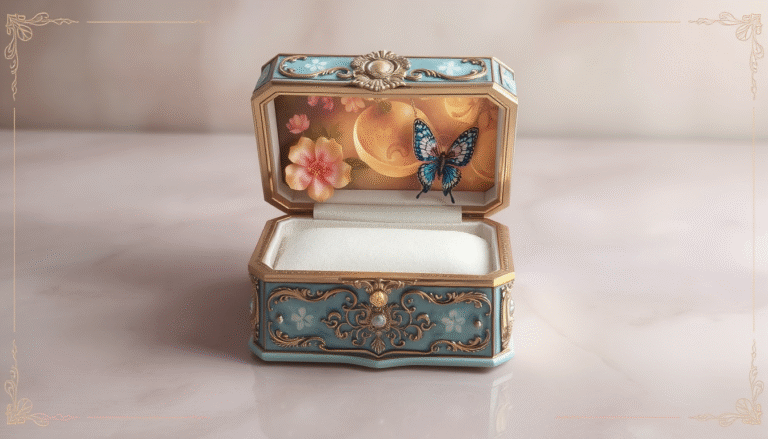You have a beautiful jewelry collection that is made with love and attention to details. Do customers look at it? The difference between a good piece of furniture and a good lead lies in the presentation. If your valuable pieces aren’t getting snapped up, it may not be the jewelry at fault, but the way you are displaying it.
A retail jewelry display stands for is holder not only. It’s a silent salesperson that presents your products, relates your brand story, and that turns a brief look into an actual sale.
This guide is based on our real-life experience of helping store owners to optimize his/her space. This guide will take you through how to choose the perfect stands for you, how to display them to maximize your investment, and how to use your displays to reflect your brand and make you more sales.
The Foundation: Why Strategic Jewelry Displays Are Non-Negotiable
Treating displays as a place to keep necklaces from tangling is to miss their real purpose. They do, however, organize your collection — and, their real power, of making jewelry look more expensive, more valuable and the customers wanting to buy. This is an investment in your business, and not just an expense.
The materials and design of your stands affect how customers see your jewelry. A delicate gold chain on a velvet bust looks more valuable than the same chain on a plastic rack. This idea is backed by research into the psychology in your visual merchandising, which shows that better presentation makes items seem higher quality and worth more money.
Your displays speak about your brand to customers before you do. What it does: The style of your product stands for cheap jewelry stands for retail displays and retail is a statement about what kind of store you are. Studies have shown that purchasing decisions are often made in the store, and how things look is one of the biggest factors in what customers decide.
Are you minimalist, bohemian, classic luxury? That question should be answered very quickly by your displays.
-
Minimalist Brand: Think clean acrylic blocks, sleek metal T-bars, and a single-color design. The focus is on the shape and form of the jewelry.
-
Bohemian Brand: Use natural textures. Try wood risers with rough edges, linen trays, and brass stands with an old-looking finish to create a warm, earthy feel.
-
Luxury Brand: Choose rich materials. Velvet busts, high-quality leather-look pads, and polished chrome or gold-tone risers show luxury and exclusivity.
A Practical Guide: Matching the Stand to the Sparkle
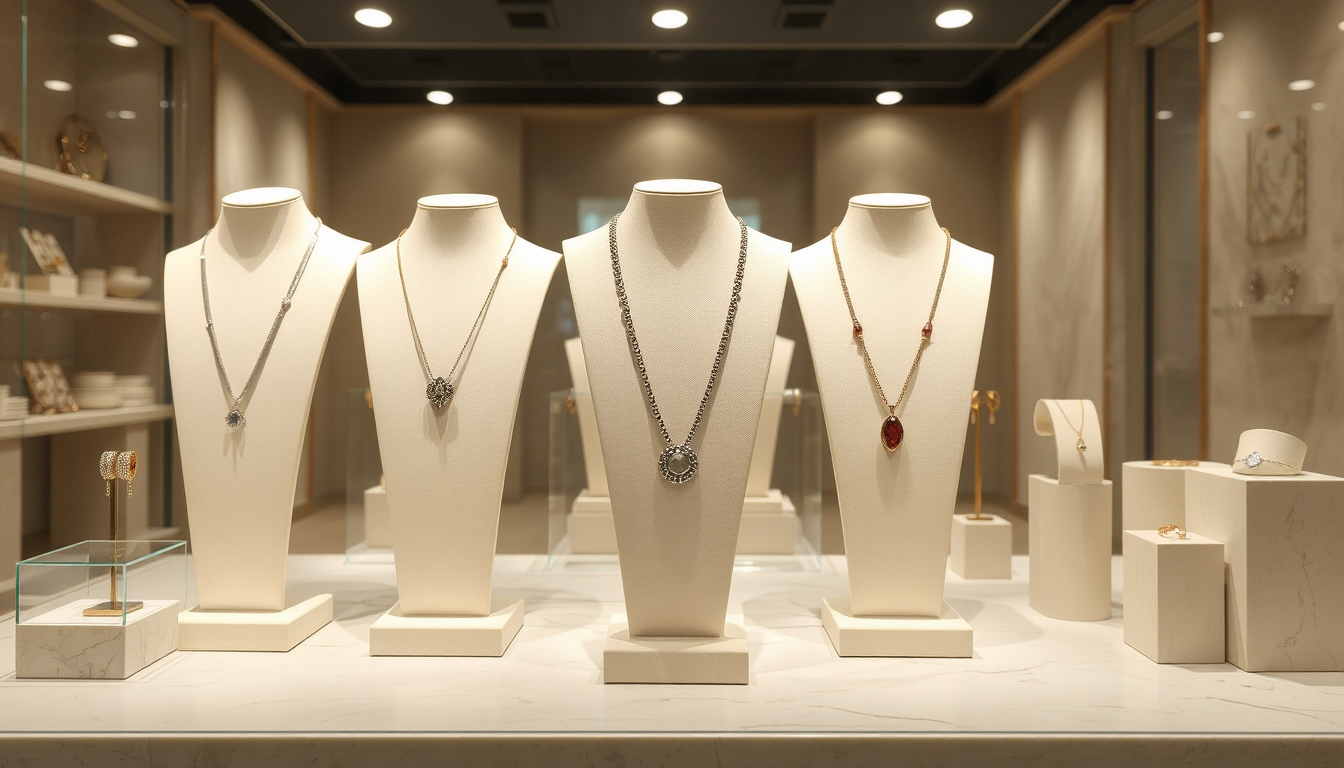
Not all stands are right for all jewelry. The wrong display can mask or distort a piece’s best features.
Here, by category, is a breakdown of the key types of jewelry display stands for retail to ensure that every piece looks its very best.
For Necklaces: Creating Elegant Lines
For necklaces, you’ll want to provide a good view of the length and the design. This allows customers to envision how the items will look on their bodies.
-
Busts/Mannequins: These are the ideal silhouette for the best garments. A bust demonstrates how a necklace will look on a person.” Employ tall busts for long necklaces and shorter, wider ones for collars and chokers.
-
T-Bar Stands (Tall): you’ll want at least 2 of these if you like to compare styles side by side. A tall, multi-level T-bar makes it possible to exhibit multiple pendants and chains of various lengths without them twisting together, allowing customers to easily browse and compare.
-
Easels/Ramps: These are great for countertop in-case (inside glass) displays. They are great to hold up shorter chains, chokers or pendants in an angle that reflects light and is beautiful.
For Earrings: Ensuring Visibility and Separation
Earrings are small and detailed. Their displays have to ensure they don’t “get lost” and allow potential borrowers to see clearly each of the designs.
-
Rotating Racks:A must have for a store with a lot of carded earrings. They are space-saving for a reason, and inspire a little interaction from customers having to turn the rack around to check out your collection.
-
T-Stands (Short): Great for dangle and hook earrings. Utilize stands of various heights to keep your selection interesting and display varying lengths and styles.
-
Stud/Hole Displays: No doubt you cannot live without by far is stud earrings. Be it an acrylic block with holes or the velvet board, these stands store up tiny studs and make pairs easy to spot.
For Bracelets & Watches: Highlighting Wristwear
Bracelet and watch displays are expected to appear tasteful. They ought to provide customers a sense of how the piece will fit on their wrist.
-
Pillows & Ramps: These do not scream expensive. A soft pillow in a glass case makes a watch or heavy bracelet appear more expensive. Ramps offer a tidy, angled view that showcases workmanship.
-
Cylinder/Roll Bars: These are easy and functional. They enable you to wear a few bangles, cuffs or chain bracelets at once. Employees can quickly pull a piece for a customer to try on.
-
Hand Displays: They just leave me speechless. A mannequin hand demonstrates how a bracelet or watch looks on when worn, and can help the customer envision it on themselves.
For Rings: Focusing on the Details
Ring presentations must be shown winein their best light and provide elevation. They can highlight the minutiae of the stone and setting.
-
Finger Cones/Stands: Great to display a single ring. Crumple up your group arrangement to stand them at the same height, or use them to build a lovely still life — “moments” that feel like on purpose but not studied and perfect.
-
Slotted Trays/Inserts: Industry standard for managing rings. Whether nestled in a case or on a countertop, these foam or velvet inserts maintain ring positions upright and arranged for sorting according to type.
The Art of Arrangement: Mastering Retail Visual Merchandising

Simply having the right stands isn’t enough on its own. The magic comes with how you order them. Good visual merchandising takes a customer’s eye on a journey, tells a story, and makes your jewelry irresistible.
Create a Visual Hierarchy
You want customers to look where you want them to look first. A uniform flat presentation is tedious and oppressive. Your objective is to produce focus and flow.
Use risers. This is arguably the MOST important rule. Elevate the stuff that matters most — high-profit items or new arrivals — on risers like acrylic blocks, wooden boxes or sets of nesting risers. This also gives you varying heights, provides strong focal points and moves the eye across your collection.
The Power of Grouping and Storytelling
Never display items randomly. Curated clusters means you can sell sets of items rather than individual pieces.
We have seen stores lift the sales of sets by more than 30% simply by changing how they present their products. Ciara suggests not silk, since that can crease like you wouldn’t believe, but something a bit more forgiving than a full-blown stiff silhouette, and don’t think of a necklace and earrings as two separate entities. Are you presenting them as is?
-
DO: Create compelling visual stories. Merchandise by theme: a “Rose Gold Story” with all the items on rose-tinted displays, or a “Gifts Under $100” section displayed on clean, bright white stands.
-
DON’T: Pair clashing styles without a reason. Chunky turquoise jewelry next to delicate diamond pieces leads to confusion and the two appear less than they are. If you have to mix styles, put a piece with no provocation in both between.
Leverage Negative Space
Clutter makes things look cheap. Overpacking your sideboards diminishes your values and says “sale.”
Negative space — the empty area surrounding your displays — is as essential as the displays, themselves. It allows each of those pieces to breathe, and it tells a customer that these pieces are special and one should pay attention to them.
Think of your display case as an art gallery, not a storeroom. A gallery doesn’t clog their surfaces with paintings; your jewelry deserves the same treatment.
Mini Case Study: The “Evening Gala” Display
And here’s a real world example of this in practice, in a display that’s specifically designed to sell MORE products.
-
Objective: To sell a high-profit diamond necklace and encourage the purchase of matching earrings.
-
Setup:
-
A central, tall black velvet bust features the hero necklace. This is the clear focal point.
-
This bust sits on a clear acrylic riser, raising it just an inch above everything else.
-
To the left and slightly forward, a shorter, matching black velvet T-stand displays the coordinating earrings. Its lower height ensures it supports, not competes with, the necklace.
-
To the right, a single, discreet slotted ring tray shows a few complementary diamond rings.
-
A single spotlight from above aims directly at the main diamond pendant, making it sparkle.
- Result: This setup creates a clear main item, tells a cohesive story (“your complete look for the gala”), and makes buying the earrings too feel natural.
Future-Focused Displays: Sustainability and Innovation
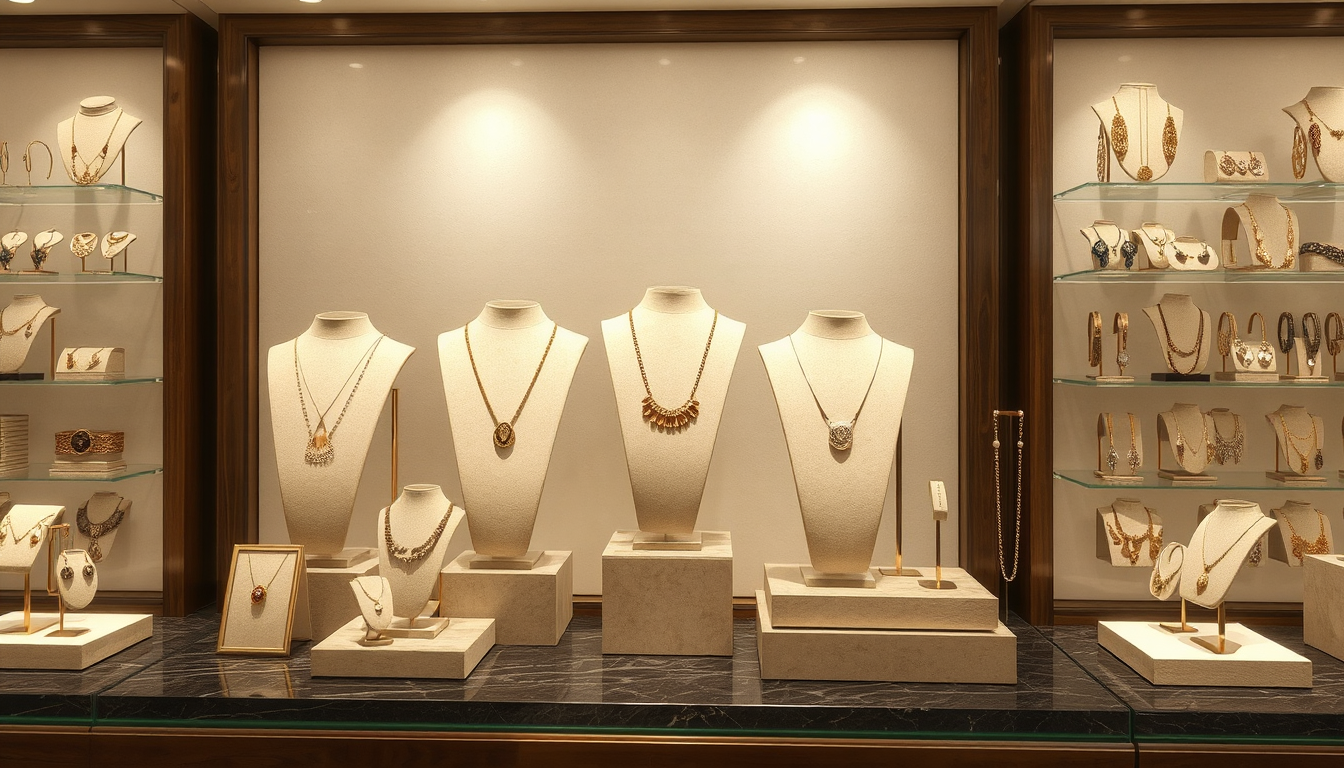
Today, customers don’t simply shop for products — they shop for the values that a brand projects. Positioning your store as modern and responsible can help differentiate you. This is thinking about the retail displays of the future.
The Rise of Sustainable Jewelry Displays
Sustainability isn’t just for a small group of people anymore; it’s what most consumers expect. Shoppers, especially younger ones, actively look for brands that share their values. As leading publications note, there are clear trends in sustainable jewelry store design, and your displays are a visible way to show this.
By demonstrating your brand’s concern for the environment, you can attract current and future customers when you incorporate eco-friendly materials into your jewelry display stands for retail.
-
Reclaimed Wood: Offers a unique, rustic look with a good story behind it.
-
Bamboo: A fast-growing resource that provides a clean, modern look.
-
Recycled Acrylic/Resin: Gives you that contemporary, polished look but with less environmental impact.
-
Linen & Organic Cotton: Use these natural fabrics instead of synthetic materials for pillows, pads, and bust coverings.
Integrating Simple Tech for an Enhanced Experience
Innovation doesn’t need to come in the form of pricey rainbow screens. It doesn’t take much to add affordable tech to your displays and elevate customer experience.
-
QR Codes: Place a small, well-designed QR code next to an important display. This code can link to your website, a video of someone wearing the jewelry, or information about where the gemstone came from.
-
NFC Tags: These tags are even more seamless. A customer can tap their smartphone near the tag to instantly see product information, styling tips, or an “add to cart” option. This connects your physical store with your online presence.
Conclusion: From Display to Delight
And the jewelry display stand for retail can be placed not only static props. They are your most diligent employees — assets at branding, storytelling, and sales promotion.
You can turn your store from a shop into a gallery simply by following the advice in this guide. To summarize the key actions:
-
Choose stands that truly reflect your brand and work well for each type of jewelry.
-
Arrange your displays using visual merchandising principles—hierarchy, grouping, and negative space—to tell stories and guide the eye.
-
Innovate by using sustainable materials and simple technology to meet modern consumers’ expectations.
By taking a new, jewelry-like approach to a display and treating it with the same love and attention you do your jewelry, you have a game they cannot refuse. You transform browsers into buyers and create a more profitable, resilient brand.
FAQ
-
What are the most effective types of jewelry display stands for retail in 2025?
The best stands will vary by type of jewelry: mannequin busts for necklaces, rotating racks for earrings, plush pillows for watches/bracelets and finger cones for rings. sustainable options such as bamboo and reclaimed wood are among the popular choices in 2025. -
How can jewelry display stands increase retail sales?
Display strategically to increase perception of value, highlight jewelry’s best features, establish visual hierarchy, and tell brand stories. Up to 30% of additional sales can be driven through well merchandised sets and converting browsers to buyers. -
What materials should I choose for my jewelry display stands in 2025?
Select materials which reflect your brand: minimal brands would use clean acrylic and metal / bohemian brands would favour wood and linen/ luxury brands invest in velvet, leather look pads and polished metal finishes. -
How should I arrange my jewelry display stands for maximum impact?
Use risers to create visual hierarchy, group by category, utilize negative space to avoid over crowding, and display high-profit items at eye level. Look into sustainable possibilities and no-brainer tech integration, like QR codes, for a millennial feel. -
What sustainable jewelry display stand options are trending in 2025?
Some of the leading sustainable choices include recycled wood, rapidly renewable bamboo, upcycled acrylic/resin, and natural textiles such as linen and cotton. These environmentally friendly displays have a broad appeal to younger consumers who value a company’s brand.

